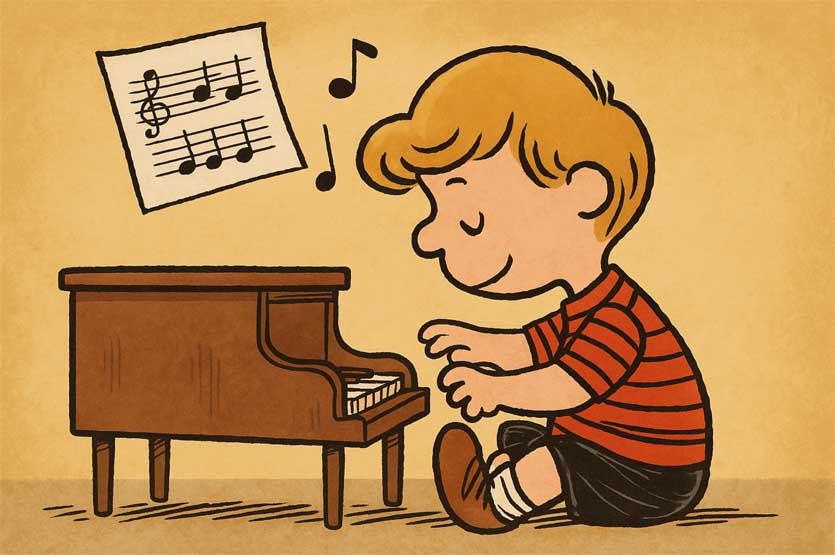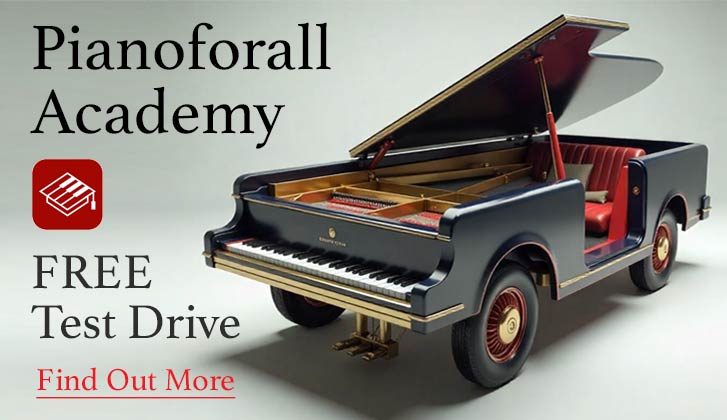If you grew up with Peanuts — whether it was reading the comic strip in the newspaper, watching the animated specials on TV, or catching reruns years later — you probably have a favourite character. Charlie Brown with his endless self-doubt, Lucy with her strong opinions, Linus with his thoughtful blanket, Snoopy with his daydreams.
For me, the one that stood out wasn’t the most talkative or the funniest — it was Schroeder, the boy with the tiny piano and the big musical obsession.
Schroeder’s Little Piano
Schroeder’s piano was famously small — barely bigger than a shoebox — but it was his world. In the strips, he would sit with total focus, completely absorbed in Beethoven. And it wasn’t just “pretend” music. Charles Schulz actually drew real excerpts from Beethoven’s sheet music into the panels. That was unusual for a comic strip, and it meant that for some readers, it might have been the first time they ever saw a real score.
That attention to detail mattered. It gave Schroeder’s passion credibility, and it quietly told readers that even a child could be deeply serious about music.
Lucy and the Piano
Of course, Schroeder’s piano was more than just an instrument — it was a stage for some of the strip’s best running jokes. Lucy would lean on it like it was a café counter, trying to start conversations or declare her love. Schroeder, barely looking up, would keep playing.
It was funny because it was so predictable — Lucy wanting connection, Schroeder lost in his music. But there was also a truth in it. For Schroeder, the piano wasn’t just a hobby. It was his safe place. A way to block out the noise of the world and focus on something he cared about completely. I think a lot of musicians — and piano students — can relate to that.
The Sound of Peanuts
When Peanuts moved from print to animation, the piano stayed central to its identity — but now it had a sound. Vince Guaraldi’s jazz piano music gave the specials their distinctive feel.
The piece “Linus and Lucy” is instantly recognisable. Just a few bars, and you’re in that Peanuts world: kids dancing awkwardly, Snoopy skating, Christmas pageants going slightly wrong.
Guaraldi’s playing was deceptively simple. It was catchy and fun, but also harmonically rich and rhythmically playful. As a teacher, I often point to his music as an example of how piano can be expressive without being overly complicated — and how learning a piece that makes people smile can be just as rewarding as tackling a difficult classical work.
Why It Still Matters
Decades later, Schroeder and the Peanuts gang still resonate. In an age of streaming, smartphones, and constant distraction, there’s something refreshing about the image of a kid fully absorbed in an instrument. It’s a reminder of what it feels like to be so interested in something that the rest of the world fades away.
And Guaraldi’s music continues to connect with people of all ages. It bridges generations — parents introduce it to their children, and those children often end up wanting to try the piano themselves.
The Takeaway
If Schroeder could create so much meaning with a small plastic piano, there’s no limit to what you can do with a full set of keys. You don’t need to be Beethoven, and you don’t have to aim for perfection. What matters is bringing your own personality to the music.
Sit down, play, and make the piano your own — whether you’re working on a Beethoven sonata, a jazz riff, or even your own version of “Linus and Lucy.” You might just find, like Schroeder, that the piano becomes your favourite place to be.



